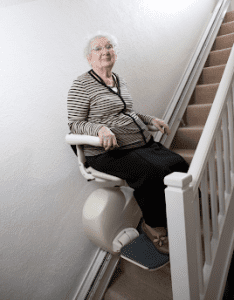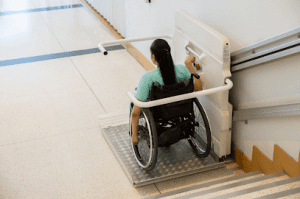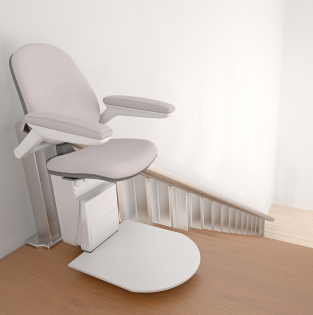The Steps to Take: Making Stairs Accessible
Stairs are a common architectural feature in homes and buildings, providing access to different levels. While they may seem like a straightforward means of getting from point A to point B, they can present significant challenges for individuals with mobility issues. In an inclusive and accessible world, it’s essential to ensure that everyone can navigate stairs comfortably and safely.
In this blog, we’ll explore some steps you can take to make stairs accessible, ensuring that everyone can move freely and independently. However, it’s important to emphasize the critical role of hiring a professional contractor who specializes in accessibility for all. A skilled contractor can make all the difference when it comes to creating truly accessible stairways that meet safety and regulatory standards.
Start with a Ramp
One of the most effective ways to make stairs accessible is by incorporating a ramp. Ramps are a practical addition that can benefit not only individuals with mobility impairments but also parents with strollers and people carrying heavy loads. When designing a ramp, consider the following:
Slope: Ensure that the slope of the ramp complies with local accessibility regulations, typically around 1:12 (one inch of rise for every 12 inches of run).
Width: Make the ramp wide enough to accommodate wheelchairs comfortably, typically at least 36 inches wide.
Surface: Choose a slip-resistant surface for the ramp to prevent accidents. Textured materials like concrete or rubber are excellent options.
Handrails: Install handrails on both sides of the ramp for added stability and support.
Add Handrails
Handrails are a crucial component of an accessible stairway. They provide stability and support to individuals with balance or mobility issues. When adding handrails, remember these key points:
Height: Install handrails at a consistent height, typically between 34 to 38 inches above the stair’s surface.
Grip: Choose handrails with a comfortable grip and ensure they extend beyond the top and bottom of the stairs.
Materials: Select materials that are durable and easy to maintain. Common choices include wood, metal, or PVC.
Colour: Consider using a contrasting colour for the handrails to make them more visible, especially for individuals with visual impairments.
Illuminate the Way
Proper lighting is essential for making stairs accessible. Insufficient lighting can create hazards and make it difficult for people to see and navigate the steps. Here are some lighting tips:
Install Motion-Activated Lights: Motion-activated lights are a great way to ensure that the stairs are well-lit when needed, saving energy when not in use.
Use LED Bulbs: LED bulbs are energy-efficient and provide bright, consistent lighting. They also have a longer lifespan, reducing maintenance.
Lighting Design: Consider the placement of lights to minimize glare and shadows, which can be disorienting for some individuals.
Apply Non-Slip Surfaces
Slippery stairs can pose a significant risk to everyone, especially those with mobility issues. To make stairs accessible, use non-slip materials or coatings:
Anti-Slip Tape: Apply anti-slip tape to the stair treads to improve traction.
Non-Slip Paint or Coatings: Consider using non-slip paint or coatings on outdoor stairs to prevent accidents in wet or icy conditions.
Rubber Mats: Place rubber mats on stair treads to provide additional grip.
Consider a Chair Lift or Elevator
For buildings with multiple levels, it may be necessary to install a chair lift or elevator to ensure full accessibility. These devices are particularly helpful for individuals who use wheelchairs or have difficulty climbing stairs. Ensure that the lift or elevator is easy to operate and maintain to accommodate everyone’s needs.

Create Visual and Tactile Cues
Visual and tactile cues can be invaluable for individuals with visual impairments. Consider these elements:
Contrasting Colours: Use contrasting colours on the edges of stairs to make them more visible.
Braille and Raised Lettering: Add Braille and raised lettering to handrails or walls to provide essential information for those with visual impairments.
Tactile Warning Strips: Install tactile warning strips at the top and bottom of stairs to alert individuals with visual impairments to changes in elevation.
Ensure Adequate Clear Space
When designing accessible stairs, it’s essential to provide ample clear space around the stairs. This allows individuals with mobility aids or those using mobility devices to maneuver comfortably. Make sure there are no obstacles or clutter in the pathway.
Regular Maintenance and Inspections
Once you’ve taken steps to make stairs accessible, it’s crucial to maintain them properly. Regular inspections and maintenance will ensure that accessibility features remain in good working condition. Address any issues promptly to prevent accidents or deterioration of accessibility features.

In conclusion, making stairs accessible is a vital step towards creating an inclusive environment where everyone can move freely and independently. By incorporating ramps, handrails, proper lighting, non-slip surfaces, and other accessibility features, you can ensure that stairs are safe and usable for people of all abilities. Remember that accessibility is an ongoing commitment, and regular maintenance is key to keeping these features in top condition. Taking these steps to make stairs accessible is a step toward a more inclusive and welcoming space for everyone. Request a Quote

